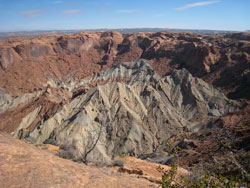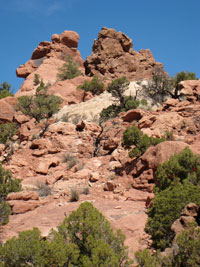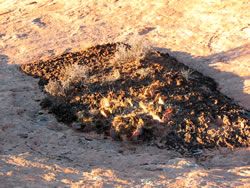HIKING HAPPENINGS
May 2009
Upheaval Dome – An Unsolved Mystery
by Marcia Hafner
In the middle of a far-reaching, windswept landscape, the bombed out appearance of Upheaval Dome is an eerie, puzzling sight to behold - a mind-boggling scene that presents an intriguing mystery. Exactly what did happen here millions of years ago?
 Until recently, scientists had assumed that Upheaval Dome was a salt dome – a logical conclusion considering the geological history of southeast Utah - three hundred million years ago when the Colorado Plateau was immersed in a large inland sea. After it evaporated, a huge deposit of salt remained. Then recurring floods, incessant winds and the steady cycle of ingoing-outgoing oceans left behind a residue that thickly covered the original bed of salt. Over time that residue transformed into layers of sandstone and a tremendous weight pressed down on the salt beneath. The more buoyant liquefied salt, however, shoved back, and a huge void called a salt dome was born. Sometimes a dome would collapse, and when erosion removed the outer layers the remnants lived on as a crater, a likely scenario for Upheaval Dome. Until recently, scientists had assumed that Upheaval Dome was a salt dome – a logical conclusion considering the geological history of southeast Utah - three hundred million years ago when the Colorado Plateau was immersed in a large inland sea. After it evaporated, a huge deposit of salt remained. Then recurring floods, incessant winds and the steady cycle of ingoing-outgoing oceans left behind a residue that thickly covered the original bed of salt. Over time that residue transformed into layers of sandstone and a tremendous weight pressed down on the salt beneath. The more buoyant liquefied salt, however, shoved back, and a huge void called a salt dome was born. Sometimes a dome would collapse, and when erosion removed the outer layers the remnants lived on as a crater, a likely scenario for Upheaval Dome.
But now research has turned up something entirely different – the meteorite impact theory. Sixty million years ago, here’s how it would have played out. A large body from outer space, traveling many times beyond the speed of sound, entered our atmosphere in a blazing fireball that lit up the sky. The impact from the crash landing carved out a large crater. It also explosively threw rocks and dust into the air creating a veil so thick, day turned into night. The tremendous blast vaporized all living things within the surrounding area and tremors were felt throughout the world.
A lot of evidence supports the meteorite impact theory, such as the discovery of shatter cones, which are conical-shaped pieces of rock buried inside the sandstone. The small grooves radiating out from their central points are believed by some to have been caused by the shock waves of a meteorite impact. Shocked quartz also shows a highly fractured structure - another indication of a powerful impact.
The name Upheaval describes the concentric circle of tilted rocks contained within the depression. This type of strata is not found for miles, giving more proof to a blow out event. Finally, evidence from seismic wave testing suggests that a force from above, not from below, punched out Upheaval Dome.
Upheaval Dome is found in the Island In The Sky section of Canyonlands National Park. To go there, drive ten miles north out of Moab on Highway 191 and turn left on to Highway 313. Then proceed another 25 miles to the park’s entrance station. Go six more miles and turn right on to the road that ends at the Upheaval Dome parking lot where parking is limited - getting there early is the best insurance to finding a spot.
At the end of the parking lot, the trail begins. It intersects with the Syncline Loop Trail, which is 8.3 miles long and can be taken in either direction. To see Upheaval Dome, go straight through the intersection and walk up the short, but steep stone steps to the very top where there’s a fork and a sign. The right fork goes 150 feet to the first overlook while the left goes half a mile to the second overlook. For different perspectives on this unusual show, try them both.
On the well-maintained trail to the second overlook, piles of stone called cairns clearly mark the route over the slickrock. A gentle dirt path guides me through the pinyon pines, the junipers and the Mormon tea, where the charming chortle of a juniper titmouse is occasionally heard above the whistling breeze. On the final stretch of my hike I climb up a stone staircase and some “chiseled-out-of-the rock” Moki steps.
 At the finish line I am standing at a vantage point, where I can see for miles and miles and miles into a wild, uninhabited land. The wide-open, steely blue sky touches landforms in all directions - the La Sal Mountains, The Bookcliffs, The Henry Mountains and the jagged outline of sandstone walls and domes. In between I can pick out Cleopatra’s Chair above The Maze and the sheer cliffs that encase the meanderings of the Green River. At the finish line I am standing at a vantage point, where I can see for miles and miles and miles into a wild, uninhabited land. The wide-open, steely blue sky touches landforms in all directions - the La Sal Mountains, The Bookcliffs, The Henry Mountains and the jagged outline of sandstone walls and domes. In between I can pick out Cleopatra’s Chair above The Maze and the sheer cliffs that encase the meanderings of the Green River.
These exposed viewpoints, however, tend to be windy during the cooler months of the year so be sure to bring a windbreaker along. I squeeze in between the rocks for a more sheltered, comfortable spot and pleasurably rest my back on slanted slickrock. The break that I am taking becomes much longer than intended, but I crave that extra time to absorb the massive, overpowering drama presented by the sheer, finicky, grainy-powder texture of Upheaval Dome. In a fractured land flavored by the coloring of blue-gray, with patches of coffee-brown thrown into the mix, a few hardier forms of vegetation struggle to get a foothold – a testament to their tenacity in a territory that looks ready to slip-slide away.
As I continue to gaze upon this perplexing phenomenon, a witness to an age-old spectacle, I keep wondering -will the mystery of Upheaval Dome ever be solved? Go see it for yourself and draw your own conclusions.
Some additional information: The 527 square miles of Canyonlands became a national park in 1964. It is segmented into three distinct areas – Island In the Sky, (north) The Needles (south) and The Maze (west) and has two major rivers, The Green and The Colorado running through it. Island In The Sky and The Needles are easily accessible with any vehicle, but to visit The Maze, a high-clearance, four-wheel drive is required.
|
Biological Soil Crust (aka)
Cryptos (krip’ tose):
The surface of
Moab’s desert is held
together by a thin skin of living organisms known as cryptobiotic
soil or cryptos. It has a lumpy black appearance, is very
fragile, and takes decades to heal when it has been damaged.
This soil is a critical part of the survival of the desert.
The cryptobiotic organisms help to stabilize the soil, hold
moisture, and provide protection for germination of the seeds
of other plants. Without it the dry areas of the west would
be much different. Although some disturbance is normal and
helps the soil to capture moisture, excessive disturbance
by hooves, bicycle tires and hiking boots has been shown
to destroy the cryptobiotic organisms and their contribution
to the soil. When you walk around Moab avoid crushing the
cryptos. Stay on trails, walk in washes, hop from stone to
stone. Whatever it takes, don’t crunch the cryptos
unless you absolutely have to! |

Cryptobiotic soil garden
|
|
|
 Until recently, scientists had assumed that Upheaval Dome was a salt dome – a logical conclusion considering the geological history of southeast Utah - three hundred million years ago when the Colorado Plateau was immersed in a large inland sea. After it evaporated, a huge deposit of salt remained. Then recurring floods, incessant winds and the steady cycle of ingoing-outgoing oceans left behind a residue that thickly covered the original bed of salt. Over time that residue transformed into layers of sandstone and a tremendous weight pressed down on the salt beneath. The more buoyant liquefied salt, however, shoved back, and a huge void called a salt dome was born. Sometimes a dome would collapse, and when erosion removed the outer layers the remnants lived on as a crater, a likely scenario for Upheaval Dome.
Until recently, scientists had assumed that Upheaval Dome was a salt dome – a logical conclusion considering the geological history of southeast Utah - three hundred million years ago when the Colorado Plateau was immersed in a large inland sea. After it evaporated, a huge deposit of salt remained. Then recurring floods, incessant winds and the steady cycle of ingoing-outgoing oceans left behind a residue that thickly covered the original bed of salt. Over time that residue transformed into layers of sandstone and a tremendous weight pressed down on the salt beneath. The more buoyant liquefied salt, however, shoved back, and a huge void called a salt dome was born. Sometimes a dome would collapse, and when erosion removed the outer layers the remnants lived on as a crater, a likely scenario for Upheaval Dome. At the finish line I am standing at a vantage point, where I can see for miles and miles and miles into a wild, uninhabited land. The wide-open, steely blue sky touches landforms in all directions - the La Sal Mountains, The Bookcliffs, The Henry Mountains and the jagged outline of sandstone walls and domes. In between I can pick out Cleopatra’s Chair above The Maze and the sheer cliffs that encase the meanderings of the Green River.
At the finish line I am standing at a vantage point, where I can see for miles and miles and miles into a wild, uninhabited land. The wide-open, steely blue sky touches landforms in all directions - the La Sal Mountains, The Bookcliffs, The Henry Mountains and the jagged outline of sandstone walls and domes. In between I can pick out Cleopatra’s Chair above The Maze and the sheer cliffs that encase the meanderings of the Green River.